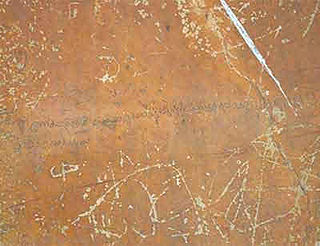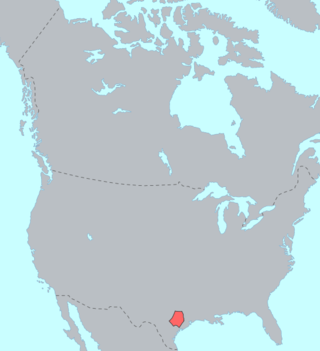
An abugida – sometimes also called alphasyllabary, neosyllabary, or pseudo-alphabet – is a segmental writing system in which consonant–vowel sequences are written as units; each unit is based on a consonant letter, and vowel notation is secondary, similar to a diacritical mark. This contrasts with a full alphabet, in which vowels have status equal to consonants, and with an abjad, in which vowel marking is absent, partial, or optional – in less formal contexts, all three types of the script may be termed "alphabets". The terms also contrast them with a syllabary, in which a single symbol denotes the combination of one consonant and one vowel.
In phonetics, aspiration is the strong burst of breath that accompanies either the release or, in the case of preaspiration, the closure of some obstruents. In English, aspirated consonants are allophones in complementary distribution with their unaspirated counterparts, but in some other languages, notably most South Asian languages and East Asian languages, the difference is contrastive.

The Dravidian languages are a family of languages spoken by 250 million people, mainly in southern India, north-east Sri Lanka, south-west Pakistan and some regions of Nepal. Dravidian is first attested in the 2nd century BCE, as inscriptions in Tamil-Brahmi script on cave walls in the Madurai and Tirunelveli districts of Tamil Nadu.
In the linguistic study of written languages, a syllabary is a set of written symbols that represent the syllables or moras which make up words.
A syllable is a unit of organization for a sequence of speech sounds, typically made up of a syllable nucleus with optional initial and final margins. Syllables are often considered the phonological "building blocks" of words. They can influence the rhythm of a language, its prosody, its poetic metre and its stress patterns. Speech can usually be divided up into a whole number of syllables: for example, the word ignite is made of two syllables: ig and nite.
In linguistics, reduplication is a morphological process in which the root or stem of a word or even the whole word is repeated exactly or with a slight change.

Sinhala, sometimes called Sinhalese, is an Indo-Aryan language primarily spoken by the Sinhalese people of Sri Lanka, who make up the largest ethnic group on the island, numbering about 16 million. Sinhala is also spoken as the first language by other ethnic groups in Sri Lanka, totalling about 2 million speakers as of 2001. It is written using the Sinhala script, which is a Brahmic script closely related to the Grantha script of South India.

Hadza is a language isolate spoken along the shores of Lake Eyasi in Tanzania by around 1,000 Hadza people, who include in their number the last full-time hunter-gatherers in Africa. It is one of only three languages in East Africa with click consonants. Despite the small number of speakers, language use is vigorous, with most children learning it, but UNESCO categorizes the language as vulnerable.

The Tonkawa language was spoken in Oklahoma, Texas, and New Mexico by the Tonkawa people. A language isolate, with no known related languages, Tonkawa has not had L1 speakers since the mid 1900s. Most Tonkawa people now only speak English, but revitalization is underway.
Shm-reduplication is a form of reduplication originating in Yiddish in which the original word or its first syllable is repeated with the copy beginning with shm-, pronounced. The construction is generally used to indicate irony, sarcasm, derision, skepticism, or lack of interest with respect to comments about the discussed object. In general, the new combination is used as an interjection.

Eastern Pomo, also known as Clear Lake Pomo, is a nearly extinct Pomoan language spoken around Clear Lake in Lake County, California by one of the Pomo peoples.
Vedic Sanskrit has a number of linguistic features which are alien to most other Indo-European languages. Prominent examples include: phonologically, the introduction of retroflexes, which alternate with dentals, and morphologically, the formation of gerunds. Some philologists attribute such features, as well as the presence of non-Indo-European vocabulary, to a local substratum of languages encountered by Indo-Aryan peoples in Central Asia (Bactria-Marghiana) and within the Indian subcontinent during Indo-Aryan migrations, including the Dravidian languages.

Aguaruna is an indigenous American language of the Chicham family spoken by the Aguaruna people in Northern Peru. According to Ethnologue, based on the 2007 Census, 53,400 people out of the 55,700 ethnic group speak Aguaruna, making up almost the entire population. It is used vigorously in all domains of life, both written and oral. It is written with the Latin script. The literacy rate in Aguaruna is 60-90%. However, there are few monolingual speakers today; nearly all speakers also speak Spanish. The school system begins with Aguaruna, and as the students progress, Spanish is gradually added. There is a positive outlook and connotation in regard to bilingualism. 50 to 75% of the Aguaruna population are literate in Spanish. A modest dictionary of the language has been published.
Tamil phonology is characterised by the presence of "true-subapical" retroflex consonants and multiple rhotic consonants. Its script does not distinguish between voiced and unvoiced consonants; phonetically, voice is assigned depending on a consonant's position in a word, voiced intervocalically and after nasals except when geminated. Tamil phonology permits few consonant clusters, which can never be word initial.
Taos is a Tanoan language spoken by several hundred people in New Mexico, in the United States. The main description of its phonology was contributed by George L. Trager in a (pre-generative) structuralist framework. Earlier considerations of the phonetics-phonology were by John P. Harrington and Jaime de Angulo. Trager's first account was in Trager (1946) based on fieldwork 1935-1937, which was then substantially revised in Trager (1948). The description below takes Trager (1946) as the main point of departure and notes where this differs from the analysis of Trager (1948). Harrington's description is more similar to Trager (1946). Certain comments from a generative perspective are noted in a comparative work Hale (1967).
Emae, Emwae or Mae language, is a Polynesian outlier language of Vanuatu.
Awara is one of the Finisterre languages of Papua New Guinea. It is part of a dialect chain with Wantoat, but in only 60–70% lexically similar. There are around 1900 Awara speakers that live on the southern slopes of the Finisterre Range, they live along the east and west sides of Leron River basin.
Pendau, or Umalasa, is a Celebic language of Sulawesi in Indonesia spoken by the approximately 4000 Pendau people who live in Central Sulawesi. Classified as an endangered language, Pendau is primarily spoken inside of Pendau villages whereas Indonesian is used to speak with neighboring communities and is the language of children's education and outside officials. The highest concentration of speakers is in and around Kecamatan Balaesang. There are no known dialects within the Pendau region, although speakers from the mainland can identify whether a speaker is from the Balaesang peninsula through their 'rhythm' or intonation pattern. In recent years, some Pendau leaders have worked with local government to preserve their language alongside Indonesian.
Wamesa is an Austronesian language of Indonesian New Guinea, spoken across the neck of the Doberai Peninsula or Bird's Head. There are currently 5,000–8,000 speakers. While it was historically used as a lingua franca, it is currently considered an under-documented, endangered language. This means that fewer and fewer children have an active command of Wamesa. Instead, Papuan Malay has become increasingly dominant in the area.






